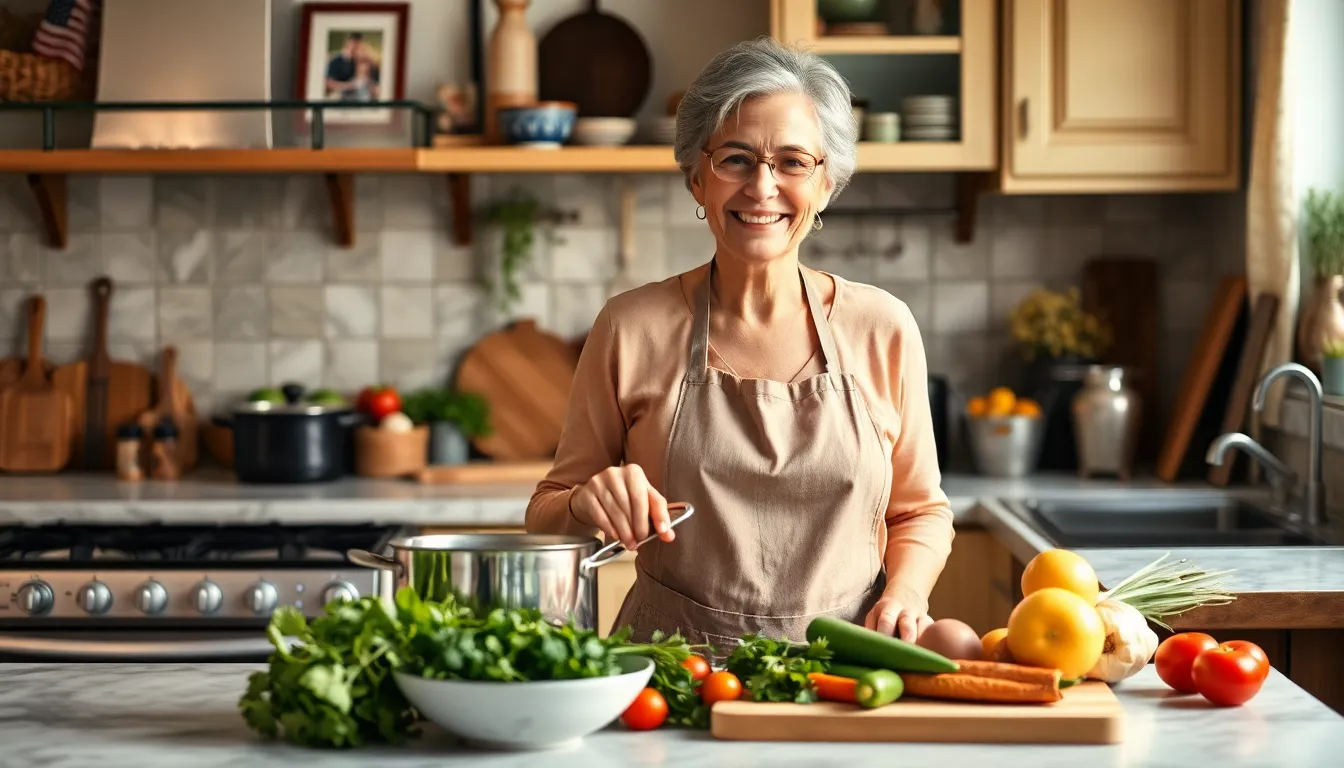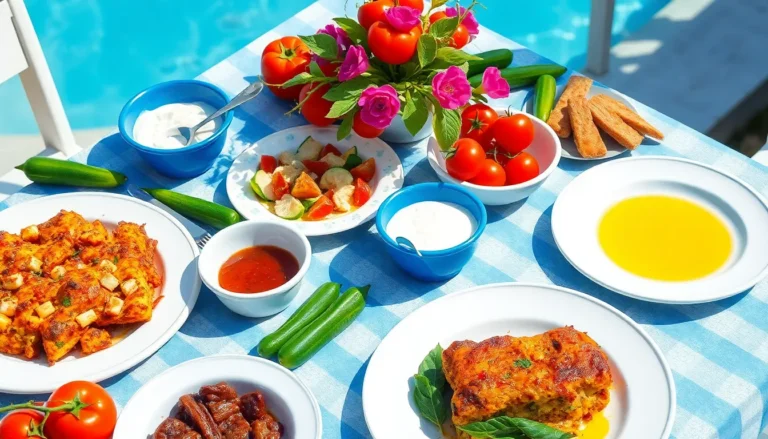Table of Contents
ToggleIn a world where fast food reigns supreme, traditional recipes offer a delicious reminder of culinary heritage. These time-honored dishes connect people to their roots, preserving flavors and techniques passed down through generations. From hearty stews to delicate pastries, each recipe tells a story that reflects cultural identity and family traditions.
Exploring traditional recipes not only satisfies the palate but also fosters a sense of community. Cooking together can strengthen bonds among family and friends while celebrating diverse backgrounds. As more people seek authentic experiences in their kitchens, the revival of these cherished recipes becomes essential for keeping culinary traditions alive. Whether it’s the comforting aroma of a grandmother’s soup or the vibrant colors of a festive dish, traditional recipes hold the power to bring people together around the table.
Overview of Traditional Recipes
Traditional recipes embody culinary heritage, reflecting cultural identities through time-honored practices. These recipes often rely on locally sourced ingredients, emphasizing regional flavors and seasonal produce. Heirloom techniques, passed down through generations, showcase cooking methods that resonate with historical significance and authenticity.
Traditional recipes foster community bonding as families and friends gather to create and share meals. Recipes like coq au vin from France or paella from Spain illustrate how specific dishes symbolize their originating cultures. Celebrating these dishes encourages the continuation of culinary customs, ensuring that future generations appreciate their cultural roots.
In addition, traditional recipes often evoke nostalgia, reminding individuals of cherished memories linked to special gatherings. The act of preparing these foods not only preserves flavor profiles but also cements familial ties. Communities benefit from a revival of traditional cooking, as younger generations learn to appreciate and recreate their ancestors’ dishes.
Understanding the value of traditional recipes fosters a deeper appreciation for cultural diversity, bridging gaps between various culinary traditions and uniting people through shared gastronomic experiences. The resurgence in popularity of these recipes promotes sustainable eating practices, as local ingredients become staples in homes, minimizing the reliance on mass-produced food.
Cultural Significance of Traditional Recipes

Traditional recipes serve as vital links to cultural identity, offering insights into history and regional diversity. They evoke a sense of belonging while celebrating culinary heritage.
Regional Variations
Regional variations in traditional recipes showcase local ingredients and distinct cooking methods, emphasizing the diversity within culinary practices. Each dish reflects its area’s culture, climate, and available resources. For example, gumbo from Louisiana incorporates unique spices and seafood, while Italian risotto uses local rice varieties and seasonal vegetables. These variations foster understanding of cultural identities and encourage appreciation for different food traditions.
Historical Context
The historical context of traditional recipes reveals their evolution and significance throughout time. Many dishes originated from practical necessities, such as preserving food before refrigeration. Recipes like kimchi in Korea or sauerkraut in Germany trace back to the need for food preservation and nourishment during harsh seasons. These culinary traditions carry stories of survival, resilience, and adaptation, connecting generations through shared histories and practices. Understanding this context helps preserve recipes for future generations, ensuring that cultural legacies remain intact.
Common Ingredients in Traditional Recipes
Traditional recipes often feature specific ingredients that resonate with cultural heritage. Understanding these ingredients reveals the essence of the dishes and their significance in different cuisines.
Staple Foods
Staple foods represent the foundation of many traditional recipes. These ingredients typically provide the bulk of nutrition and vary by region.
- Grains: Rice, wheat, and corn serve as primary carbohydrates in various cultures. Rice appears in dishes like sushi in Japan and risotto in Italy. Wheat is essential for pasta in Italy and bread in many other regions. Corn features in tortillas in Mexico and polenta in Italy.
- Legumes: Beans, lentils, and peas are nutritional powerhouses in traditional diets. Black beans are fundamental in Cuban cuisine, while chickpeas figure prominently in Middle Eastern dishes like hummus and falafel.
- Root Vegetables: Potatoes, yams, and carrots often serve as comfort foods in many recipes. Potatoes are crucial for Irish colcannon and Spanish patatas bravas, while yams frequently appear in soul food dishes in the Southern United States.
Herbs and Spices
Herbs and spices enhance flavors and add depth to traditional recipes. They embody regional characteristics and cooking traditions.
- Basil: Widely used in Mediterranean dishes, basil enhances flavors in pesto and Caprese salad. Its aromatic profile offers a fresh note to various sauces.
- Cumin: A staple in Indian, Middle Eastern, and Mexican cuisines, cumin adds warmth to curries, chili, and tacos. Its earthy flavor is fundamental to traditional spice blends.
- Cilantro: Commonly used in Latin American and Southeast Asian dishes, cilantro adds brightness to salsas, curries, and salads. Its unique flavor profile distinguishes many traditional recipes.
- Rosemary: This herb features prominently in Mediterranean cooking, often included in roasted meats and potatoes. It imparts a distinctive aroma that enhances the dish’s overall appeal.
Incorporating these staple foods and herbs in traditional recipes not only preserves culinary heritage but also connects individuals with their cultural roots.
Famous Traditional Recipes
Traditional recipes from around the world highlight the rich culinary heritage of different cultures. Each region’s unique dishes tell a story through their ingredients and cooking methods.
Recipe from Europe
Coq au vin represents classic French cuisine, featuring chicken braised with red wine, lardons, mushrooms, and pearl onions. Known for its depth of flavor, this dish showcases the French technique of slow-cooking and elevates regional wine. Another notable recipe, Italian risotto, combines Arborio rice with broth, onions, and Parmesan cheese. Its creamy texture comes from gradual stirring, emphasizing the importance of patience and precision in Italian cooking traditions.
Recipe from Asia
Kimchi stands out as a staple in Korean cuisine, consisting of fermented vegetables, typically napa cabbage and radishes, seasoned with chili pepper, garlic, and ginger. Its tangy flavor reflects centuries of preservation techniques vital for survival. In China, Peking duck showcases an iconic dish featuring crispy skin and tender meat, traditionally served with pancakes and hoisin sauce. This recipe illustrates the Chinese emphasis on balance and presentation in culinary practices.
Recipe from the Americas
In the Americas, tamales embody Mexican culinary traditions, made from masa (corn dough) filled with meats, cheeses, or vegetables, then wrapped in corn husks and steamed. This dish represents community, as families often gather to prepare large batches for celebrations. Another famous dish, Brazilian feijoada, consists of black beans stewed with various cuts of pork and beef. This hearty meal expresses the blend of cultures in Brazil and reflects the importance of sharing food among friends and family.
Tips for Cooking Traditional Recipes
- Use fresh ingredients: Choose seasonal, locally sourced ingredients for optimal flavor and authenticity. Fresh basil, ripe tomatoes, and organic grains enhance traditional recipes.
- Follow time-honored techniques: Adhere to established cooking methods to preserve the dish’s authenticity. Braising, fermenting, and slow-cooking reflect the cultural heritage of the recipe.
- Pay attention to proportions: Use correct measurements for ingredients, as traditional recipes rely on specific ratios. Accurate ingredient proportions ensure consistent flavors.
- Respect cooking times: Follow recommended cooking durations to achieve the desired texture and flavor. Cooking items like rice or beans too long can alter their intended qualities.
- Experiment with regional variations: Explore variations of traditional recipes that highlight local ingredients. This fosters creativity while maintaining cultural relevance.
- Involve family or friends: Encourage shared cooking experiences with community members to strengthen ties. Cooking together creates a communal atmosphere that enhances the culinary experience.
- Understand the historical context: Research the origins of each recipe to appreciate its cultural significance. Knowledge about historical influences adds depth to the cooking process.
- Document your process: Take notes while preparing traditional recipes to track adjustments or personal twists. Recording experiences helps others replicate or innovate based on the original dish.
- Preserve leftovers: Store any remaining dishes properly, as traditional recipes often improve in flavor over time. An airtight container in the refrigerator or freezer can prolong freshness.
- Share your results: Offer meals to family, friends, or neighbors to foster community and celebrate culinary traditions. Sharing food strengthens bonds and promotes cultural appreciation.
Embracing traditional recipes offers a meaningful way to connect with cultural heritage and foster community bonds. These dishes not only tell stories of the past but also encourage sustainable practices by utilizing local ingredients. As families gather around the table to share meals rooted in history, they strengthen ties and create lasting memories.
Reviving these time-honored recipes ensures that culinary traditions endure for future generations. By appreciating the nuances of regional variations and the significance of authentic cooking methods, individuals can celebrate diversity and unity through food. Ultimately, traditional recipes serve as a bridge linking people to their roots while enriching their lives with flavor and history.







